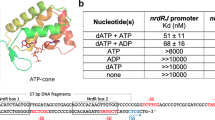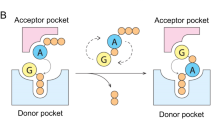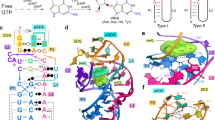Abstract
The cyclic diguanylate (bis-(3′-5′)-cyclic dimeric guanosine monophosphate, c-di-GMP) riboswitch is the first known example of a gene-regulatory RNA that binds a second messenger. c-di-GMP is widely used by bacteria to regulate processes ranging from biofilm formation to the expression of virulence genes. The cocrystal structure of the c-di-GMP responsive GEMM riboswitch upstream of the tfoX gene of Vibrio cholerae reveals the second messenger binding the RNA at a three-helix junction. The two-fold symmetric second messenger is recognized asymmetrically by the monomeric riboswitch using canonical and noncanonical base-pairing as well as intercalation. These interactions explain how the RNA discriminates against cyclic diadenylate (c-di-AMP), a putative bacterial second messenger. Small-angle X-ray scattering and biochemical analyses indicate that the RNA undergoes compaction and large-scale structural rearrangement in response to ligand binding, consistent with organization of the core three-helix junction of the riboswitch concomitant with binding of c-di-GMP.
This is a preview of subscription content, access via your institution
Access options
Subscribe to this journal
Receive 12 print issues and online access
$189.00 per year
only $15.75 per issue
Buy this article
- Purchase on Springer Link
- Instant access to full article PDF
Prices may be subject to local taxes which are calculated during checkout




Similar content being viewed by others
Accession codes
References
Jenal, U. & Malone, J. Mechanisms of cyclic-di-GMP signaling in bacteria. Annu. Rev. Genet. 40, 385–407 (2006).
Tamayo, R., Pratt, J.T. & Camilli, A. Roles of cyclic diguanylate in the regulation of bacterial pathogenesis. Annu. Rev. Microbiol. 61, 131–148 (2007).
Wolfe, A. & Visick, K. Get the message out: cyclic-di-GMP regulates multiple levels of flagellum-based motility. J. Bacteriol. 190, 463–475 (2008).
Pesavento, C. & Hengge, R. Bacterial nucleotide-based second messengers. Curr. Opin. Microbiol. 12, 170–176 (2009).
Weinberg, Z. et al. Identification of 22 candidate structured RNAs in bacteria using the CMfinder comparative genomics pipeline. Nucleic Acids Res. 35, 4809–4819 (2007).
Sudarsan, N. et al. Riboswitches in eubacteria sense the second messenger cyclic di-GMP. Science 321, 411–413 (2008).
Xiao, H., Edwards, T.E. & Ferré-D'Amaré, A.R. Structural basis for specific, high-affinity tetracycline binding by an in vitro evolved aptamer and artificial riboswitch. Chem. Biol. 15, 1125–1137 (2008).
Ferré-D'Amaré, A.R. & Doudna, J.A. Crystallization and structure determination of a hepatitis delta virus ribozyme: use of the RNA-binding protein U1A as a crystallization module. J. Mol. Biol. 295, 541–556 (2000).
Oubridge, C., Ito, N., Evans, P.R., Teo, C.-H. & Nagai, K. Crystal structure at 1.92Å resolution of the RNA-binding domain of the U1A spliceosomal protein complexed with an RNA hairpin. Nature 372, 432–438 (1994).
Robertson, M.P. & Scott, W.G. The structural basis of ribozyme-catalyzed RNA assembly. Science 315, 1549–1553 (2007).
Xiao, H., Murakami, H., Suga, H. & Ferré-D'Amaré, A.R. Structural basis of specific tRNA aminoacylation by a small in vitro selected ribozyme. Nature 454, 358–361 (2008).
Klein, D., Edwards, T. & Ferré-D'Amaré, A. Cocrystal structure of a class I preQ1 riboswitch reveals a pseudoknot recognizing an essential hypermodified nucleobase. Nat. Struct. Mol. Biol. 16, 343–344 (2009).
Robertson, M.P. & Scott, W.G. A general method for phasing novel complex RNA crystal structures without heavy-atom derivatives. Acta Crystallogr D 64, 738–744 (2008).
Rupert, P.B. & Ferré-D'Amaré, A.R. Crystal structure of a hairpin ribozyme-inhibitor complex with implications for catalysis. Nature 410, 780–786 (2001).
Ferré-D'Amaré, A.R. The hairpin ribozyme. Biopolymers 73, 71–78 (2004).
Lipfert, J. & Doniach, S. Small-angle X-ray scattering from RNA, proteins, and protein complexes. Annu. Rev. Biophys. Biomol. Struct. 36, 307–327 (2007).
Baird, N., Westhof, E., Qin, H., Pan, T. & Sosnick, T. Structure of a folding intermediate reveals the interplay between core and peripheral elements in RNA folding. J. Mol. Biol. 352, 712–722 (2005).
Ehresmann, C. et al. Probing the structure of RNAs in solution. Nucleic Acids Res. 15, 9109–9128 (1987).
Dock-Bregeon, A.C., Garcia, A., Giegé, R. & Moras, D. The contacts of yeast tRNA(Ser) with seryl-tRNA synthetase studied by footprinting experiments. Eur. J. Biochem. 188, 283–290 (1990).
Mei, H.Y. et al. Inhibitors of protein-RNA complexation that target the RNA: specific recognition of human immunodeficiency virus type 1 TAR RNA by small organic molecules. Biochemistry 37, 14204–14212 (1998).
Hallegger, M., Taschner, A. & Jantsch, M.F. RNA aptamers binding the double-stranded RNA-binding domain. RNA 12, 1993–2004 (2006).
Pouch-Pélissier, M.N. et al. SINE RNA induces severe developmental defects in Arabidopsis thaliana and interacts with HYL1 (DRB1), a key member of the DCL1 complex. PLoS Genet. 4, e1000096 (2008).
Savochkina, L., Alekseenkova, V., Belyanko, T., Dobrynina, N. & Beabealashvilli, R. RNA protections from RNase V1 due to RNA structure alone. BMC Res. Notes 1, 15 (2008).
Esakova, O., Perederina, A., Quan, C., Schmitt, M.E. & Krasilnikov, A.S. Footprinting analysis demonstrates extensive similarity between eukaryotic RNase P and RNase MRP holoenzymes. RNA 14, 1558–1567 (2008).
Batey, R.T., Gilbert, S.D. & Montange, R.K. Structure of a natural guanine-responsive riboswitch complexed with the metabolite hypoxanthine. Nature 432, 411–415 (2004).
Serganov, A. et al. Structural basis for discriminative regulation of gene expression by adenine- and guanine-sensing mRNAs. Chem. Biol. 11, 1729–1741 (2004).
Witte, G., Hartung, S., Büttner, K. & Hopfner, K.P. Structural biochemistry of a bacterial checkpoint protein reveals diadenylate cyclase activity regulated by DNA recombination intermediates. Mol. Cell 30, 167–178 (2008).
Edwards, T.E. & Ferré-D'Amaré, A.R. Crystal structures of the thi-box riboswitch bound to thiamine pyrophosphate analogs reveal adaptive RNA-small molecule recognition. Structure 14, 1459–1468 (2006).
Gilbert, S.D., Reyes, F.E., Edwards, A.L. & Batey, R.T. Adaptive ligand binding by the purine riboswitch in the recognition of guanine and adenine analogs. Structure 17, 857–868 (2009).
Collins, J.A., Irnov, I., Baker, S. & Winkler, W.C. Mechanism of mRNA destabilization by the glmS ribozyme. Genes Dev. 21, 3356–3368 (2007).
Klein, D.J., Been, M.D. & Ferré-D'Amaré, A.R. Essential role of an active-site guanine in glmS ribozyme catalysis. J. Am. Chem. Soc. 129, 14858–14859 (2007).
Edwards, T.E., Klein, D.J. & Ferré-D'Amaré, A.R. Riboswitches: small-molecule recognition by gene regulatory RNAs. Curr. Opin. Struct. Biol. 17, 273–279 (2007).
Henkin, T. Riboswitch RNAs: using RNA to sense cellular metabolism. Genes Dev. 22, 3383–3390 (2008).
Serganov, A. The long and the short of riboswitches. Curr. Opin. Struct. Biol. 19, 251–259 (2009).
Lipfert, J. et al. Structural transitions and thermodynamics of a glycine-dependent riboswitch from Vibrio cholerae. J. Mol. Biol. 365, 1393–1406 (2007).
Serganov, A., Huang, L. & Patel, D. Structural insights into amino acid binding and gene control by a lysine riboswitch. Nature 455, 1263–1267 (2008).
Garst, A.D., Héroux, A., Rambo, R.P. & Batey, R.T. Crystal structure of the lysine riboswitch regulatory mRNA element. J. Biol. Chem. 283, 22347–22351 (2008).
Mulhbacher, J. & Lafontaine, D.A. Ligand recognition determinants of guanine riboswitches. Nucleic Acids Res. 35, 5568–5580 (2007).
Tomsic, J., Mcdaniel, B., Grundy, F. & Henkin, T. Natural variability in S-adenosylmethionine (SAM)-dependent riboswitches: S-box elements in Bacillus subtilis exhibit differential sensitivity to SAM in vivo and in vitro. J. Bacteriol. 190, 823–833 (2008).
Wickiser, J.K., Cheah, M.T., Breaker, R.R. & Crothers, D.M. The kinetics of ligand binding by an adenine-sensing riboswitch. Biochemistry 44, 13404–13414 (2005).
Wickiser, J.K., Winkler, W.C., Breaker, R.R. & Crothers, D.M. The speed of RNA transcription and metabolite binding kinetics operate an FMN riboswitch. Mol. Cell 18, 49–60 (2005).
Brünger, A.T. et al. Crystallography and NMR system: a new software system for macromolecular structure determination. Acta Crystallogr D 54, 905–921 (1998).
Leontis, N.B. & Westhof, E. Geometric nomenclature and classification of RNA base pairs. RNA 7, 499–512 (2001).
Ferré-D'Amaré, A.R. & Doudna, J.A. Use of cis- and trans-ribozymes to remove 5′ and 3′ heterogeneities from milligrams of in vitro transcribed RNA. Nucleic Acids Res. 24, 977–978 (1996).
Rupert, P.B. & Ferré-D'Amaré, A.R. Crystallization of the hairpin ribozyme: illustrative protocols. Methods Mol. Biol. 252, 303–311 (2004).
Heras, B. & Martin, J.L. Post-crystallization treatments for improving diffraction quality of protein crystals. Acta Crystallogr D 61, 1173–1180 (2005).
Otwinowski, Z. & Minor, W. Processing of diffraction data collected in oscillation mode. Methods Enzymol. 276, 307–326 (1997).
McCoy, A.J. et al. Phaser crystallographic software. J. Appl. Cryst. 40, 658–674 (2007).
Jones, T.A., Zou, J.Y., Cowan, S.W. & Kjeldgaard, M. Improved methods for building protein models in electron density maps and the location of errors in these models. Acta Crystallogr. A 47, 110–119 (1991).
Laskowski, R.J., Macarthur, M.W., Moss, D.S. & Thornton, J.M. PROCHECK: a program to check stereochemical quality of protein structures. J. Appl. Cryst. 26, 283–291 (1993).
Carson, M. Ribbons. Methods Enzymol. 277, 493–505 (1997).
Svergun, D.I. Restoring low resolution structure of biological macromolecules from solution scattering using simulated annealing. Biophys. J. 76, 2879–2886 (1999).
Volkov, V.V. & Svergun, D.I. Uniqueness of ab initio shape determination in small-angle scattering. J. Appl. Cryst. 36, 860–864 (2003).
Wriggers, W., Milligan, R.A. & McCammon, J.A. Situs: a package for docking crystal structures into low-resolution maps from electron microscopy. J. Struct. Biol. 125, 185–195 (1999).
Pettersen, E. et al. UCSF Chimera–a visualization system for exploratory research and analysis. J. Comput. Chem. 25, 1605–1612 (2004).
Svergun, D.I., Bargerato, C. & Koch, M.H.J. CRYSOL-a program to evaluate X-ray solution scattering of biological macromolecules from atomic coordinates. J. Appl. Cryst. 28, 768–773 (1995).
Acknowledgements
We thank the staff of ALS beamline 8.2.2 and J. Bolduc for assistance with synchrotron and home laboratory single-crystal diffraction data collection, respectively, L. Guo from BioCAT at the Advanced Photon Source (APS) for assistance with SAXS data collection and T. Hamma, J. Pitt, J. Posakony, A. Roll-Mecak and H. Suga for discussions. Use of the APS was supported by the US Department of Energy, Basic Energy Sciences, Office of Science, under contract No. W-31-109-ENG-38. BioCAT is a US National Institutes of Health–supported Research Center (RR-08630). This work was supported by the Howard Hughes Medical Institute (HHMI) and the W.M. Keck Foundation. A.R.F.-D. is an Investigator of the HHMI.
Author information
Authors and Affiliations
Contributions
N.K. designed and prepared RNA constructs, analyzed ligand binding, obtained crystals, carried out diffraction data collection and participated in structure determination and in SAXS data collection. N.J.B. participated in SAXS data collection, analyzed the SAXS data and designed, performed and analyzed the nuclease probing experiments. A.R.F.-D. participated in diffraction data collection, structure determination and refinement. All authors contributed to manuscript preparation.
Corresponding author
Supplementary information
Supplementary Text and Figures
Supplementary Figures 1–11, Supplementary Tables 1 and 2 and Supplementary Methods (PDF 1528 kb)
Rights and permissions
About this article
Cite this article
Kulshina, N., Baird, N. & Ferré-D'Amaré, A. Recognition of the bacterial second messenger cyclic diguanylate by its cognate riboswitch. Nat Struct Mol Biol 16, 1212–1217 (2009). https://doi.org/10.1038/nsmb.1701
Received:
Accepted:
Published:
Issue Date:
DOI: https://doi.org/10.1038/nsmb.1701
This article is cited by
-
The fluorescent aptamer Squash extensively repurposes the adenine riboswitch fold
Nature Chemical Biology (2022)
-
Two nucleotide second messengers regulate the production of the Vibrio cholerae colonization factor GbpA
BMC Microbiology (2015)
-
Recognition of the bacterial alarmone ZMP through long-distance association of two RNA subdomains
Nature Structural & Molecular Biology (2015)
-
Rapid RNA–ligand interaction analysis through high-information content conformational and stability landscapes
Nature Communications (2015)
-
c-di-AMP binds the ydaO riboswitch in two pseudo-symmetry–related pockets
Nature Chemical Biology (2014)



